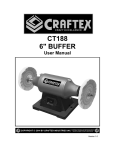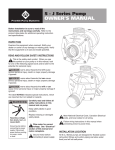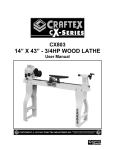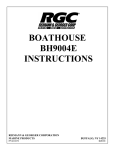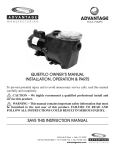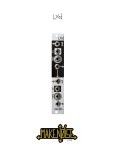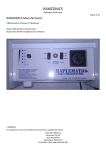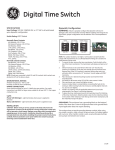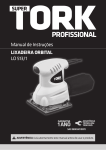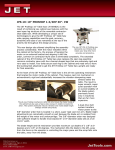Download Craftsman 21181 - 8 in. Bench Buffer Specifications
Transcript
6” Buffer 241-1450 • Use recommended accessories. Use of improper accessories may cause risk of injury to persons. • Do not overtighten wheel nut. Replace defective wheel immediately. Use only flanges supplied with the buffer. • Handle the workpiece correctly. POWER SOURCE WARNING: Do not connect buffer to the power source until all assembly steps have been completed. The motor is designed for operation on the voltage and frequency specified. Normal loads will be handled safely on voltages not more than 10% above or below specified voltage. Running the unit on voltages which are not within range may cause overheating and motor burn-out. Heavy loads require that voltage at motor terminals be no less than the voltage specified on nameplate. CAUTION: Think safety! Safety is a combination of operator common sense and alertness at all times when tool is being used. WARNING: Do not attempt to operate tool until it is completely assembled according to the instructions. • Power supply to the motor is controlled by a single pole locking rocker switch. Remove the key to prevent unauthorized use. ASSEMBLY CAUTION: Do not attempt assembly if parts are missing. Use this manual to order replacement parts. GROUNDING INSTRUCTIONS WARNING: Improper connection of equipment grounding IMPORTANT: Do not attempt assembly if parts are missing. Use this manual to order replacement parts. • Check with a qualified electrician if grounding instructions are not understood or if in doubt as to whether the tool is properly grounded. • This tool is equipped with an approved 3-conductor cord rated at 150V and a 3-prong grounding type plug (Figure 1) for your protection against shock hazards. • Grounding plug should be plugged directly into a properly installed and grounded 3- prong grounding-type receptacle, as shown (Figure 1). Buffer comes completely assembled with hex nuts, wheel flanges and spacers (Key. Nos. 1, 2, and 3) packed separately. One spiral sewn wheel and one soft wheel are included. conductor can result in the risk of electrical shock. Equipment should be grounded while in use to protect operator from electrical shock. INSTALL BUFFING WHEELS To install buffing wheels on the buffer: • Remove plastic protective sleeves from armature shaft • Slide spacer (Key. No. 3) onto armature shaft. Spacers are not required when mounting several wheels to shaft. • Slide inner wheel flange (Key. No. 2) onto armature shaft. • Slide buffing wheel on to the armature shaft and butt it against the inner wheel flange. • Slide the outer wheel flange (Key. No. 2) and butt the flat side of the flange against the buffing wheel. • Tighten hex nut (Key. No. 3)on to the armature shaft. Make sure the buffing wheel is firmly held in place and the hex nut is snug against the outer wheel flange. Use additional spacers (not supplied) if required. • Install buffing wheel on other side of buffer as mentioned above. Properly Grounded Outlet Grounding Prong 3-Prong Plug Figure 1 - 3-Prong Receptacle • Do not remove or alter grounding prong in any manner. In the event of a malfunction or breakdown, grounding provides a path of least resistance for electrical shock. WARNING: Do not permit fingers to touch the terminals of plug when installing or removing from outlet. • Plug must be plugged into matching outlet that is properly installed and grounded in accordance with all local codes and ordinances. Do not modify plug provided. If it will not fit in outlet, have proper outlet installed by a qualified electrician. • Inspect tool cords periodically, and if damaged, have repaired by an authorized service facility. • Green (or green and yellow) conductor in cord is the grounding wire. If repair or replacement of the electric cord or plug is necessary, do not connect the green (or green and yellow) wire to a live terminal. • Where a 2-prong wall receptacle is encountered, it must be replaced with a properly grounded 3-prong receptacle installed in accordance with National Electric Code and local codes and ordinances. INSTALLATION MOUNT BUFFER Buffer must be mounted to a solid horizontal surface (hardware not provided). To mount buffer to metal pedestal: • Align mounting holes with corresponding holes in pedestal • Insert a ¼-20 x 1¼ “ hex head bolt with flat washer through base of buffer. • Place a ¼ “ flat washer and ¼ “ -20 hex nut from the bottom of pedestal onto the bolt. • Tighten until base is flush with the pedestal. • Using second nut on each bolt, jam tighten against the first to prevent loosening by vibration. To mount buffer to wooden bench: • Use ¼ x 1¼ “ wood screws with flat washers beneath heads. • Tighten screws until base is flush with bench top. WARNING: This work should be performed by a qualified electrician. 3 SPECIFICATIONS A temporary 3-prong to 2-prong grounding adapter (see Figure 2) is available for connecting plugs to a two pole outlet if it is properly grounded. Make Sure Grounding Lug This Is Adapter Connected 3-Prong Plug To A Known Ground Figure 2 - 2-Prong Receptacle with Adapter MODEL 241-1450 6“ BUFFER The buffer is assembled with motor and wiring installed as an integral part of the tool. Horsepower . . . . . . . . . . . . . . . . . . . . . . . . . . . . . . . . . . . . . . . . 3/4 Voltage . . . . . . . . . . . . . . . . . . . . . . . . . . . . . . . . . . . . . . . . . . .120 Amperes . . . . . . . . . . . . . . . . . . . . . . . . . . . . . . . . . . . . . . . . . .4.8 Hertz . . . . . . . . . . . . . . . . . . . . . . . . . . . . . . . . . . . . . . . . . . . . . 60 Phase. . . . . . . . . . . . . . . . . . . . . . . . . . . . . . . . . . . . . . . . . . Single RPM . . . . . . . . . . . . . . . . . . . . . . . . . . . . . . . . . . . . . . . . . . . . 3450 Rotation (viewed from left side) . . . . . . . . . . . . . . . . . .Clockwise Weight . . . . . . . . . . . . . . . . . . . . . . . . . . . . . . . . . . . . . . . . . 18 lbs 2-Prong Receptacle • Do not use a 3-prong to 2-prong grounding adapter unless permitted by local and national codes and ordinances. (A 3-prong to 2-prong grounding adapter is not permitted in Canada.) Where permitted, the rigid green tab or terminal on the side of the adapter must be securely connected to a permanent electrical ground such as a properly grounded water pipe, a properly grounded outlet box or a properly grounded wire system. WHEELS SIZE Diameter. . . . . . . . . . . . . . . . . . . . . . . . . . . . . . . . . . . . . . . . . . . . . .6 “ Bore . . . . . . . . . . . . . . . . . . . . . . . . . . . . . . . . . . . . . . . . . . . . . . . . . 1/2“ OPERATION • Many cover plate screws, water pipes and outlet boxes are not properly grounded. To ensure proper ground, grounding means must be tested by a qualified electrician. DESCRIPTION The 6 “ Buffer is equipped with totally enclosed 3/4HP motor and single-speed motor. Armature assembly is dynamically balanced for smooth operation. Motor housing is compact so long pieces of work can press against both wheels without touching the motor frame. EXTENSION CORDS • The use of any extension cord will cause some drop in voltage and loss of power. • Wires of the extension cord must be of sufficient size to carry the current and maintain adequate voltage. WARNING: Always wear safety glasses complying with United States ANSI Z87.1 before commencing power tool operation. Safety glasses are available through your Sears catalog. • Load buffing compound, appropriate for your workpiece, onto the wheel. • Carefully guide workpiece into wheel. • Keep a steady, moderate pressure on the work piece and keep it moving at an even pace for smooth buffing. • Pressing too hard overheats the motor and prematurely wears down the buffing wheels. • Use the table to determine the minimum wire size (A.W.G.) extension cord. • Use only 3-wire extension cords having 3-prong grounding type plugs and 3-pole receptacles which accept the tool plug. • If the extension cord is worn, cut, or damaged in any way, replace it immediately. Extension Cord Length Wire Size . . . . . . . . . . . . . . . . . . . . . . . . . . . . . . . . . . . A.W.G. Up to 25 ft. . . . . . . . . . . . . . . . . . . . . . . . . . . . . . . . . . . . . . . 18 25 to 50 ft. . . . . . . . . . . . . . . . . . . . . . . . . . . . . . . . . . . . . . . 16 • The buffing wheel should rotate into object being polished. NOTE: Using extension cords over 50 ft. long is not recommended. ELECTRICAL CONNECTIONS WARNING: All electrical connections must be performed by a qualified electrician. Make sure tool is off and disconnected from power source while motor is mounted, connected, reconnected or anytime wiring is inspected. 4 • The threads on the right side of the buffer (facing unit) are right hand; threads on the left side are left hand. Hold the wheels firmly to loosen the hex nut. MAINTENANCE • Replacement wheels must have a minimum rated speed of 3450 RPM. • Make sure hex nuts are tight and snug against the outer wheel flange prior to restarting buffer. • Maximum wheel diameter for Model No. 241-1450 is 6 “. • Disconnect unit from power source before replacing buffing wheels or before performing any maintenance work. TROUBLESHOOTING SYMPTOM Buffer won’t start POSSIBLE CAUSE(S) 1. Blown line fuse or tripped circuit breaker 1. If fuse is blown, replace with fuse of proper size. If breaker tripped, reset it 2. Check power supply for voltage and correct as needed 2. Low line voltage 3. Replace switch 3. Defective switch 4. Replace capacitor 4. Defective, blown capacitor CORRECTIVE ACTION Excessive vibration 1. Improper mounting of buffing wheel on buffer 2. Buffing wheels not balanced 1. Remount Motor overheating 1. Excess pressure required to buffing 2. Buffing on side of wheel 3. Motor not turning freely (without power) 1. Replace wheel 2. Perform buffing only on face of wheel 3. Clean around wheels and shaft and/or replace bearings 1. Overloading due to binding Fuses are being blown or circuit breakers tripped 2. Defective plug 3. Defective cord 4. Defective switch 5. Motor wired for different line voltage 6. Faulty internal wiring Buffer will not operate in variable speed mode 2. Remount or replace wheels 1. Clean around wheels and shaft and/or replace bearings 2. Replace plug 3. Replace cord 4. Replace switch 5. Rewire motor as per wiring diagram 6. Contact authorized Sears Service Center 1. Replace switch 2. Replace sensor 3. Replace circuit board 1. Defective variable speed switch 2. Defective sensor 3. Defective circuit board 5 Model 241-1450 Figure 3 - Replacement Parts Illustration for 6” Buffer 6








